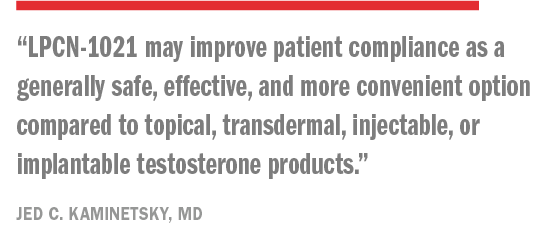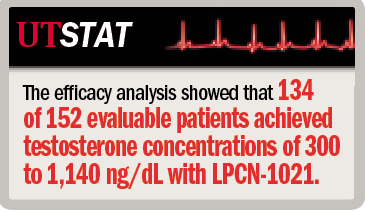Article
Oral TRT agent may improve patient compliance
A novel investigational oral testosterone replacement therapy restored and maintained testosterone levels to a eugonadal range in 88% of hypogondal men treated with the agent in a randomized clinical trial.

Dr. Kaminetsky
New Orleans-A novel investigational oral testosterone replacement therapy restored and maintained testosterone levels to a eugonadal range in 88% of hypogondal men treated with the agent in a randomized clinical trial.
The efficacy analysis of the trial showed that 134 of 152 evaluable patients achieved testosterone concentrations of 300 ng/dL to 1,140 ng/dL with the agent, known as LPCN-1021, and maintained the levels with continued treatment. In 17 cases (11.2%), the 24-hour average concentration dipped below 300 ng/dL, and one patient (0.7%) had a 24-hour average concentration that exceeded 1,140 ng/dL.
Read: What do you think of new warning labels on TRT products?
“LPCN-1021 is an orally administered product for testosterone replacement and achieves an acceptable average testosterone concentration, consistent with FDA target guidelines. Maximum concentration levels were generally consistent with FDA target guidelines,” first author Jed C. Kaminetsky, MD, assistant professor of urology at New York University, New York reported at the AUA annual meeting in New Orleans.

“LPCN-1021 may improve patient compliance as a generally safe, effective, and more convenient option compared to topical, transdermal, injectable, or implantable testosterone products,” Dr. Kaminetsky added.
The findings came from the phase III randomized SOAR (Study of Androgen Replacement) trial, involving 315 men with testosterone levels <300 ng/dL. They were randomized 2:1 to LPCN-1021 or topical testosterone therapy (Androgel). The primary objective was to determine the proportion of patients who achieved a normal 24-hour testosterone concentration after 13 weeks of treatment.
The starting dose for the LPCN-1021 group was 225 mg twice daily, taken with a standard meal. The dose could be titrated upward to 300 mg twice daily or reduced to 150 mg twice daily to maintain the 24-hour testosterone concentration within the target level.
NEXT: Agent offers novel delivery technology
More on Testosterone
Long-term TRT study refutes concerns about prostate safety
Promoting TRT online: Balanced information lacking
Injected TRT earns high marks for safety, effectiveness
Agent offers novel delivery technology

LPCN-1021 employs a novel lipid-like oral delivery technology that allows twice-daily dosing associated with improved solubility, high drug-loading capacity, improved bioavailability, and faster, more consistent absorption that leads to less variability, said Dr. Kaminetsky. The attributes could help improve adherence by avoidance of undesirable characteristics of other TRT formulations, he said.
Lipocine, Inc. provided funding for the study. Dr. Kaminetsky is an investigator for Lipocine and has a financial or other relationship with several other pharmaceutical companies. Several of Dr. Kaminetsky’s co-authors are consultants/advisers for or employees of Lipocine.
More from Urology Times:
TRT, blood clot risk evaluated in large analysis
Study: No significant link between diabetes Tx, bladder Ca
Low provider volume raises mesh removal risk
Subscribe to Urology Times to get monthly news from the leading news source for urologists.





